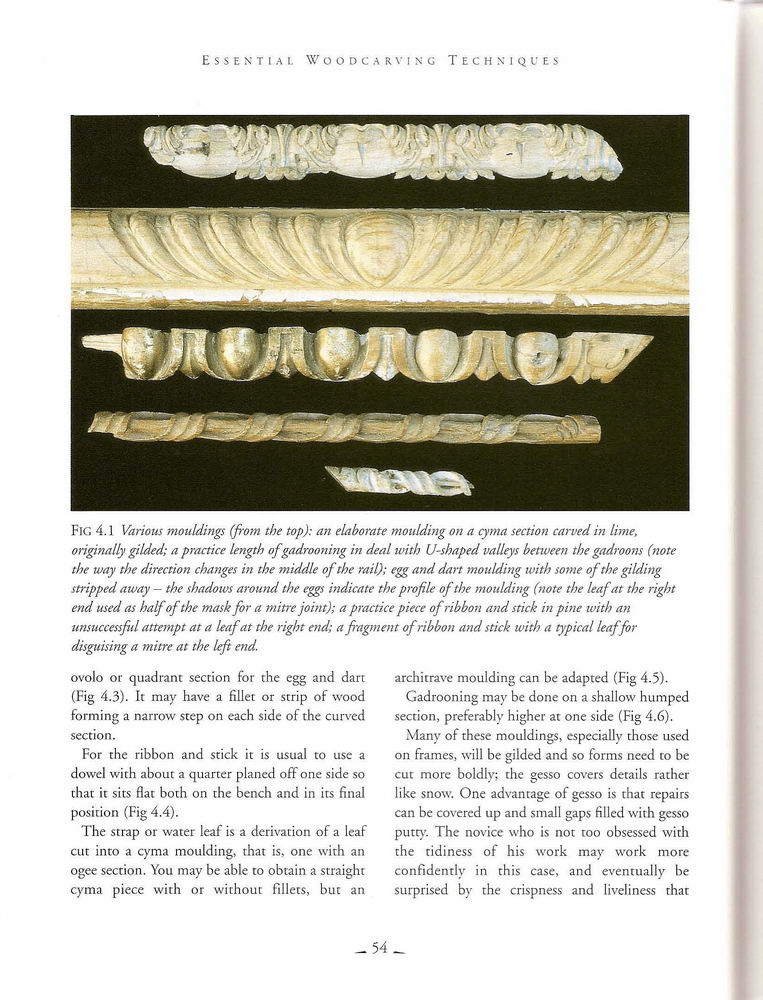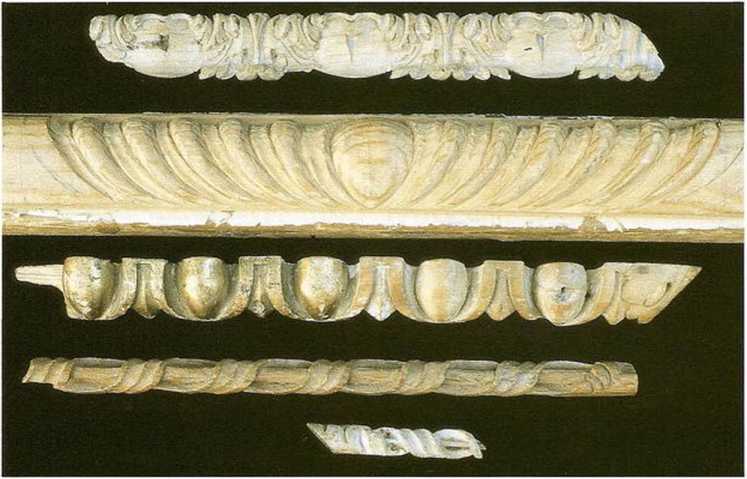essentÊrving°54

Essential Wo o d c a R VIN g Techniques

Fic. 4.1 Various mouldings (from the top): an elaborate moulding on a cyma section carued in linie, originally gilded; a practice length ofgadrooning in deal with U-sbaped yalleys between the gadroons (notę the way the direction changes in the middle of the raił); egg and dart moulding with some of the gilding stripped a way - the shadows around the eggs indicate the profile of the moulding (notę the leafat the right end used as halfof the mask for a mitrę joint); a practice piece of ribbon and stick in pine with an unsuccessfid attempt at a leafat the right end; a fragment of ribbon and stick with a typical leaffor disguising a mitrę at the lefi end.
architravc moulding can be adapted (Fig 4.5).
Gadrooning may be done on a shallow humped section, preferably higher at one side (Fig 4.6).
Many of these mouldings, cspccially those used on frames, will be gilded and so forms necd to be cut morę boldly; the gesso covers details rather like snów. One advantage of gesso is that repairs can be covered up and smali gaps fillcd with gesso putty. The novice who is not too obsessed with the tidiness of his work may work morę confidently in this casc, and eventually be surprised by the crispness and liveliness thar
ovo!o or quadrant section for the egg and dart (Fig 4.3). It may have a fillet or strip of wood forming a narrow step on each side of the curved section.
For the ribbon and stick it is usual to use a dowcl with about a quarter pianed off one side so that it sits fiat both on the bench and in its finał position (Fig 4.4).
The strap or water leaf is a derivation of a leaf cut into a cyma moulding, that is, one with an ogee section. You may be able to obtain a straight cyma piece with or without fillets, but an

Wyszukiwarka
Podobne podstrony:
essent?rving?38 Essential W o o d c a R VIN g Techniques Fic; 2.16 Obeche with pinhole borer damage.
essent?rving?31 C a r v i n c; i he Humań Figur f. Fic; 12.7 Muscles at the back of the body Fig 12.
essent?rving?50 Essen tial W o o d c a r vin g Techniques Fig 3.11 Making the stab aa at too shallow
essent?rving?55 C A R V E D M O U L D I N G S Fic, 4.2 A torus moulding in profile. FlG 4.3 Ovolo (l
essent?rving?68 E S 5E NTI A L W O O D C A R VIN G TECHNIQLES Fig 5.6 The gouge can removeplenty of
essent?rving?98 Essential Woodcarving Techniques Fig 9.1 Various lines. The one on the left Incks in
essent?rving?72 Essen tial W o o d c a r vin g Techniques Alder {Alnus glutinosa) Pale yellow or pin
essent?rving?20 Essen tul W o o d c a r v i n g Techxiquesmm FlG 1.33 Various rasps: from lefi, two
essent?rving?41 S E L E C T I X G AND B VV I N G SUITABLE W O O D Fic 2.22 The brown lines on the ne
essent?rving?52 Essen’ tial W o o d c a r v i n g Techniques Fig 3.18 A No. 3 fishtail being used to
essent?rving?63 C A R V E D M O U L D I N G S FlG 4.20 A finishedpractice section of moulding. The s
essent?rving?89 C A R V I N G A COMMONPLACE OBJECT IN H I G H R E L I F. F Making a Model and CHOOSI
essent?rving?13 C A R V I N C A Bo W L Fic; 10.14 Shaping the outside of a bowl with a No. 7, 8, 9,
essent?rving?35 Fic 12.17 NotÄ™ the fullness of the brom and tbe eyebalis and the slope np from cheek
essent?rving?85 A COMPREHENSIVE INTRODUCTION TO ESSENTIAL TOOLS, SKILLS, TECHNIQUES AND STYLES FOR T
ignition switch ESSENTIAL 1NDIVIDUAL COMPONENTSIGNITION SWITCHThe ignition switch (I) is belo w the
(b) FigurÄ™ 3 De os It ogram (a), vldeoscan <b) obtained from the essential oil of S. hlans, and m
Low-Temperature TLC—MS of Essential Oiis from the piąte before elution of the chromatographic bands
4Vapor Distillation of Essentials Oils from the Salvia Species Dried plant materiał (50 g) was place
więcej podobnych podstron